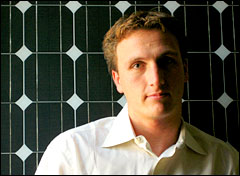Would you pay $25,000 to $30,000 to put solar panels on your home? If you’re like most cash-strapped Americans, you’d balk at that five-figure expense, no matter how green you aspire to be. OK, what if you could do it for $1,000 or $2,000?

SolarCity CEO Lyndon Rive.
SolarCity, based in sunny Silicon Valley, has just launched a new program that will push the upfront costs of a residential solar system down to a grand or two. Under the company’s SolarLease financing program, backed by Morgan Stanley, SolarCity will own the solar panels it installs on customers’ roofs, and homeowners will pay a monthly lease fee and get the resulting electricity. In many cases, customers’ total monthly electricity expenses will go down, and the power they’re getting will be green instead of brown.
Launched in 2006 by two brothers, Lyndon and Peter Rive, SolarCity also takes advantage of economies of scale by getting whole neighborhoods to go solar at once — hence the company’s name. In just a year and a half, SolarCity has grown to become the largest residential solar-panel installer in California (though it does commercial installations too), with 235 employees and $30 million in sales last year. The company has expanded into Arizona and Oregon (states which, like California, have serious subsidies for solar), and is planning to be up and running on the East Coast by the end of the year.
SolarCity CEO Lyndon Rive is an intense, earnest 31-year-old who launched two other companies before jumping into the exploding market for renewable energy. I caught up with him at the Aspen Environment Forum, where he represented his company in accepting the first-ever Aspen Institute Energy and Environment Award for Corporate Energy Generation.
Q. What makes SolarCity different from other companies that install solar panels?

There goes the neighborhood …
A. We have a unique model. We will go into a local community and educate the community about the benefits of solar, and try to get the entire community to convert to solar. By doing that, we get efficiencies of scale and we offer a discount to everyone who participates, so it’s win-win for everyone.
Q. How much does it cost to put solar panels on a home?
A. About $30,000 [before tax credits and other incentives]. Today the biggest barrier to adoption is the initial cost.
We’re launching a new service that’s going to revolutionize the adoption of solar. The homeowner will be able to pay for the system out of the savings on their electric bill. There will be a low down payment — say $1,000 or $2,000 — and then your monthly fees [to SolarCity] combined with your new electric bill will be less than your old electric bill. We’re essentially leasing people the solar systems. We’re able to capitalize on the commercial tax credits that residents aren’t able to capitalize on.
Q. You told The New York Times that you’ve been having trouble finding enough workers.
A. They left out the last sentence of my quote.
Q. What was the last sentence of your quote?
A. We’re building a training academy in a low-income, developing area of San Francisco, the Bayview-Hunters Point area. We’re about to open it up — it’ll be another month or so. The academy will allow us to train about 30 or so people every two months, and will allow us to scale up to about 60 people every month — that will be about a year or two away.
We’re trying to improve the [Bayview-Hunters Point] neighborhood. It’s been impacted, ironically enough, by an old, dirty, polluting coal power plant right next to it. Now they’ve shut down that power plant, and the city of San Francisco is trying to replace that with green companies, new innovation from cleantech. So the city is helping us with this.
Q. Who are the workers you have now?
A. Most of them come from construction, electrical, plumbing, and roofing — people who are used to working with their hands and are good with tools. Historically they’ve worked in the trades, and often get treated really badly. We pay a decent wage, give everybody full benefits, equity in the company, coffee and drinks at the warehouse. So for the first time they’ve been exposed to the same perks that software engineers have. We want to make sure that they are very happy — they are the most important thing in the company.
They have a sense of being a part of a change — they know that this person they’re installing solar for is reducing their carbon footprint. It’s a tremendously fulfilling job.
Q. Do you hear that from your employees?
A. All the time. This is my third company, and in both companies before this one, I’ve never heard such enjoyment from the workforce. They’re happy with what they’re doing.
Q. Do you call yourself an environmentalist?
A. Definitely — an environmentalist without compromise. I don’t want to live in a cave. I like my toys. But through technology and innovation, we can live the lifestyles we want to live and still be environmentally friendly.


